Plying Tips for Handspun Yarn Success
WHAT is Plying?
Plying is when bobbins containing handspun singles are removed from the wheel, placed on a lazy kate, and then subjected to more twist.
To achieve a balanced yarn, more twist is added in the opposite direction of the first twist. This is not always the case, however. Some designer yarns add the second twist in the same direction as the first twist. This article is a review of some of the key aspects of plying handspun for balanced yarns using a spinning wheel.
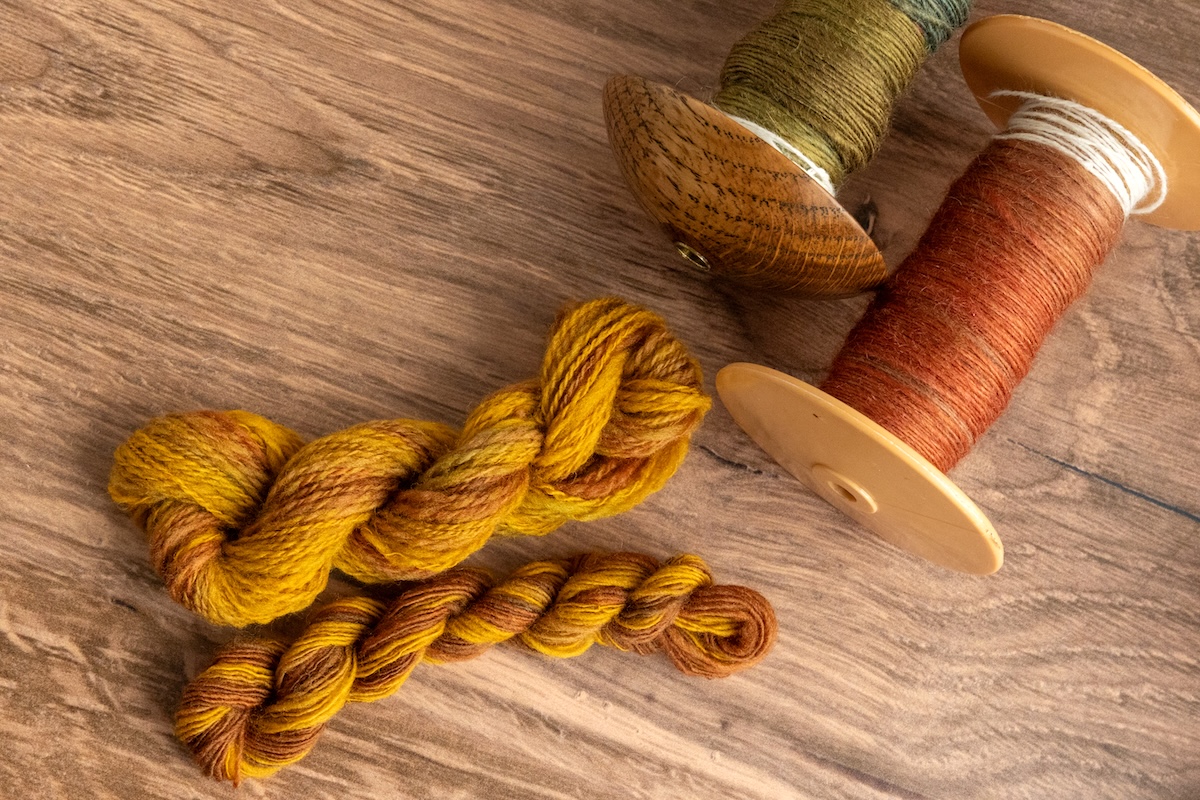
WHY Ply?
Many factors come into play when choosing whether or not to ply my singles. To give you some food for thought, here are just a few considerations I use in my own practice:
- Give a Yarn Strength
The more plies, the stronger the yarn. Unless I want a dense fabric, I usually weave with singles or 2-ply yarns. Multi-ply yarns are good for strong rug warps or fabrics requiring densely packed weft yarns. One way I can add strength to handspun handknit socks is to spin a multi-ply yarn. - Improve a Yarn’s Consistency in Grist
My singles are never perfect. They have thicker and thinner spots. When I ply my handspun, many of the thicker spots align with the thinner spots and give the appearance of a yarn that is more consistent in the grist. The more plies I use, the more even the yarn appears.
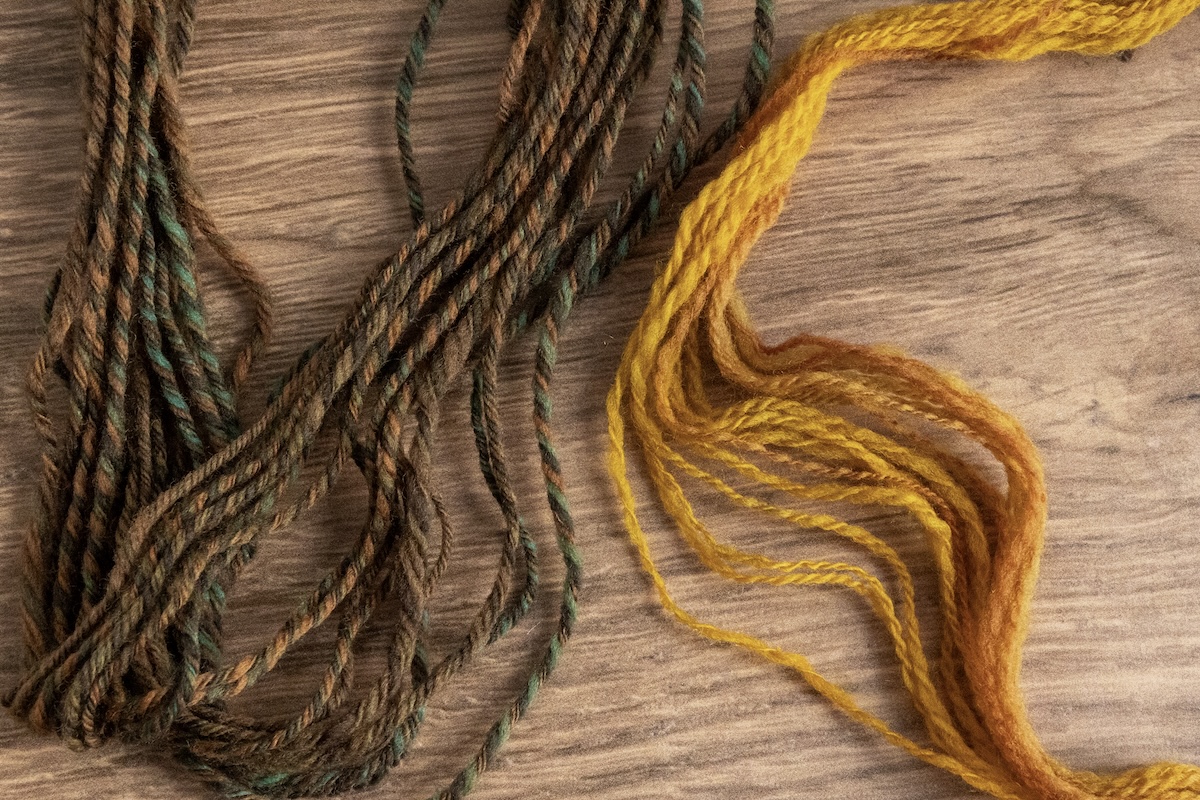
- Affect the Cross-Sectional Shape of the Yarn
The cross-section of a 2-ply yarn is flatter and more oval in shape than that of a 3-ply yarn which is rounder. In weaving (after I throw my shuttle, change the shed, and beat), the 2-ply warp and weft yarns nestle nicely into one another without packing in too closely. In knitting, a 2-ply yarn results in a more supple fabric with a better drape. Fabric knit from a 2-ply yarn also appears slightly textured when compared to fabric knit from a 3-ply yarn. When weaving, a rounder 3-ply yarn packs in more readily and helps to create a denser fabric. In knitting, the rounder 3-ply yarn fills in the stitches nicely and creates a plumper fabric with some squish to it. - Minimize Pilling
We know pilling is caused by friction and that every yarn pills. A singles yarn will pill more than a 2-ply yarn, a 2-ply will pill more than a 3-ply, and so on. Adding more twist to a yarn helps to reduce pilling, but there is something else I can do to mitigate pilling and that is plying. With this in mind, I knit shawls (which are not generally subjected to much abrasion) from either 2- or 3-ply yarns. A 3-ply yarn “shares the load”, if you will, when it comes to standing up to the abrasion that causes pilling. Because sweaters are prone to pilling, especially around the cuffs and under the arms along the body and sleeves, I knit sweaters from 3-ply yarns. This is not to say you should never use 2-ply yarns to knit sweaters. There are always exceptions to the rules. For example: I knit Shetland stranded knit sweaters from 2-ply yarns; silk pills less than wool; longer wool fibres pill less than shorter wool fibres; more tightly spun yarns pill less than more loosely spun yarns; yarns that have been wet finished via the hot/cold or thwacking methods will pill less than yarns wet finished using the soaking method, etc.
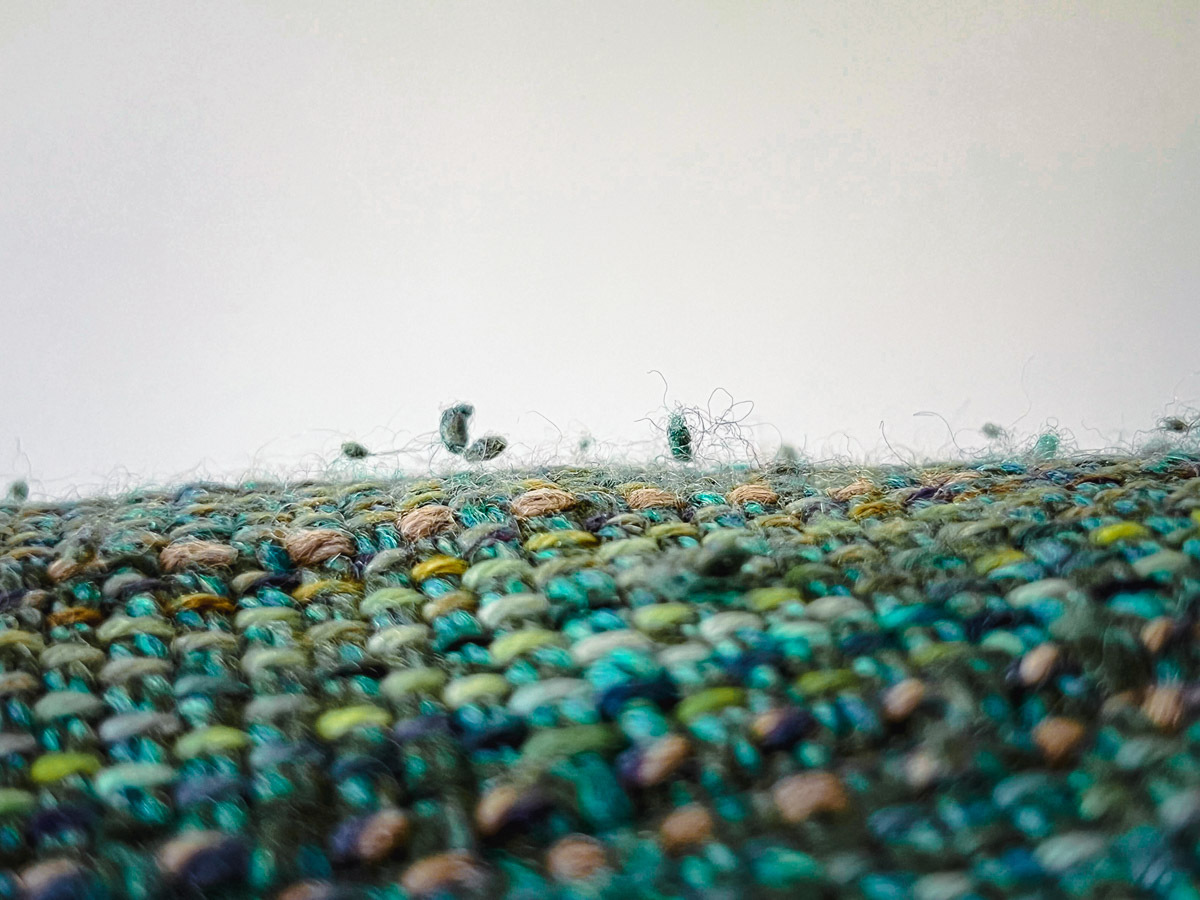
- Avoid Skewing and Tracking
I usually strive to spin and ply a balanced yarn. This not only makes the yarn easier to work with when weaving, knitting, and dyeing, but it also helps to minimize the skewing of stitches in my knitted fabric and tracking in my handwoven fabric. - Colour Effects in My Handspun
This list could be rather extensive, so I will stick to the two colour effects I use the most.
a) Self-Striping Yarn
Although I enjoy spinning self-striping yarns, it is rare for me to knit or weave a whole piece from them. I prefer to use self-striping yarns as an accent in my handwoven and knitted fabrics. There are many different ways I can achieve self-striping yarns through plying.
b) Tweed-Like Yarn
I often spin a 4-ply yarn that uses two medium-valued singles, one high-valued single and one low-valued single. I like the overall tweedy effect rendered and the fact that tweed-like fabrics work well with so many other coloured fabrics. This yarn is not a tweed in the true or pure sense of the word. However, it has a tweed-like effect. The tweed-like yarn is not the result of flecks of colour added during carding or spinning. Instead, the effect is achieved via the differing values in the singles yarns, which give the appearance of a nubby surface with pops of colour.
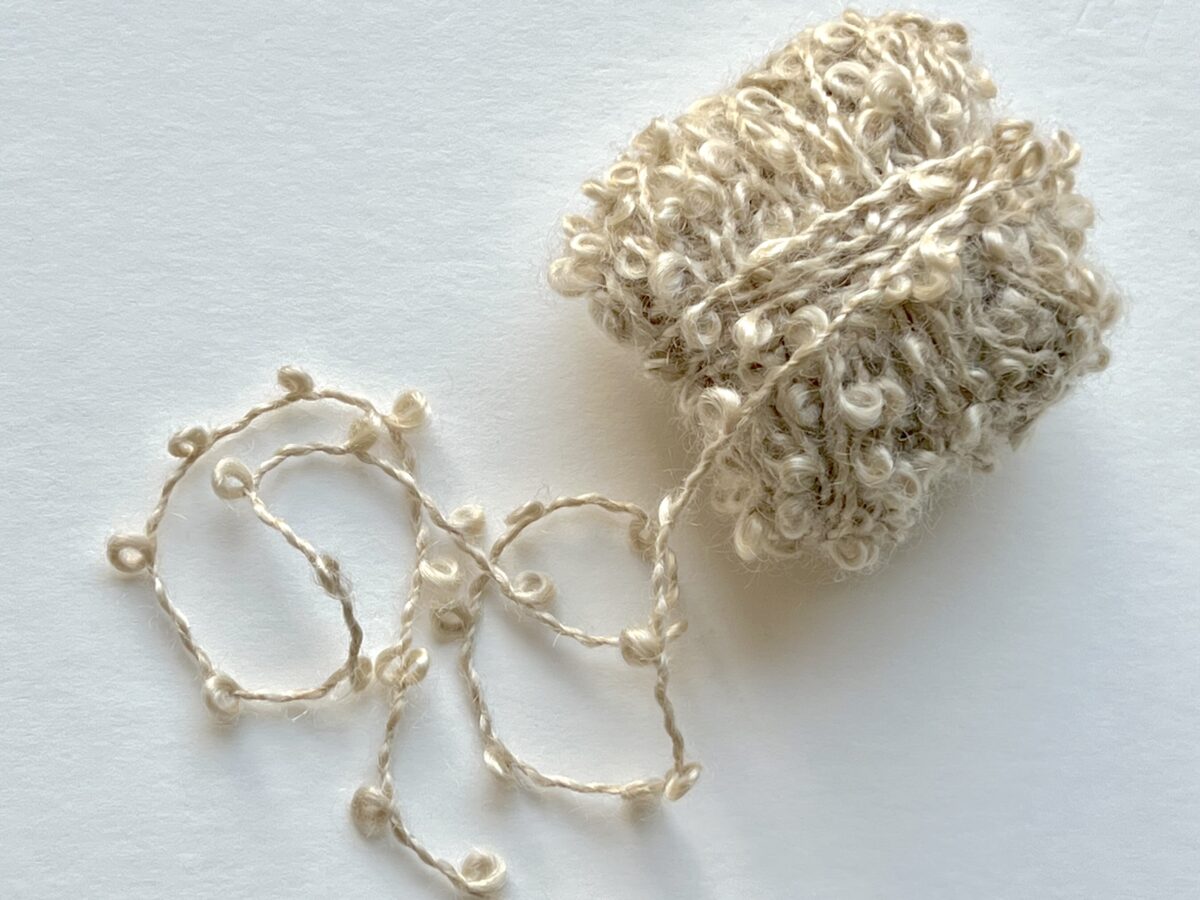
- Designer Yarns
Again, I will stick to the two yarns I spin the most.
a) Thick and Thin
I like the textural interest I get from taking a plump singles and plying it with a fine singles. It makes for a great accent yarn in both my knitting and weaving.
b) Bouclé or Almost-Bouclé
Another yarn I enjoy using as a textural accent in my work is a fine silk singles plied with a mohair or wool singles. When subjected to a hot/cold finishing method, the mohair or wool will shrink and bubble out from the silk which hardly shrinks at all.
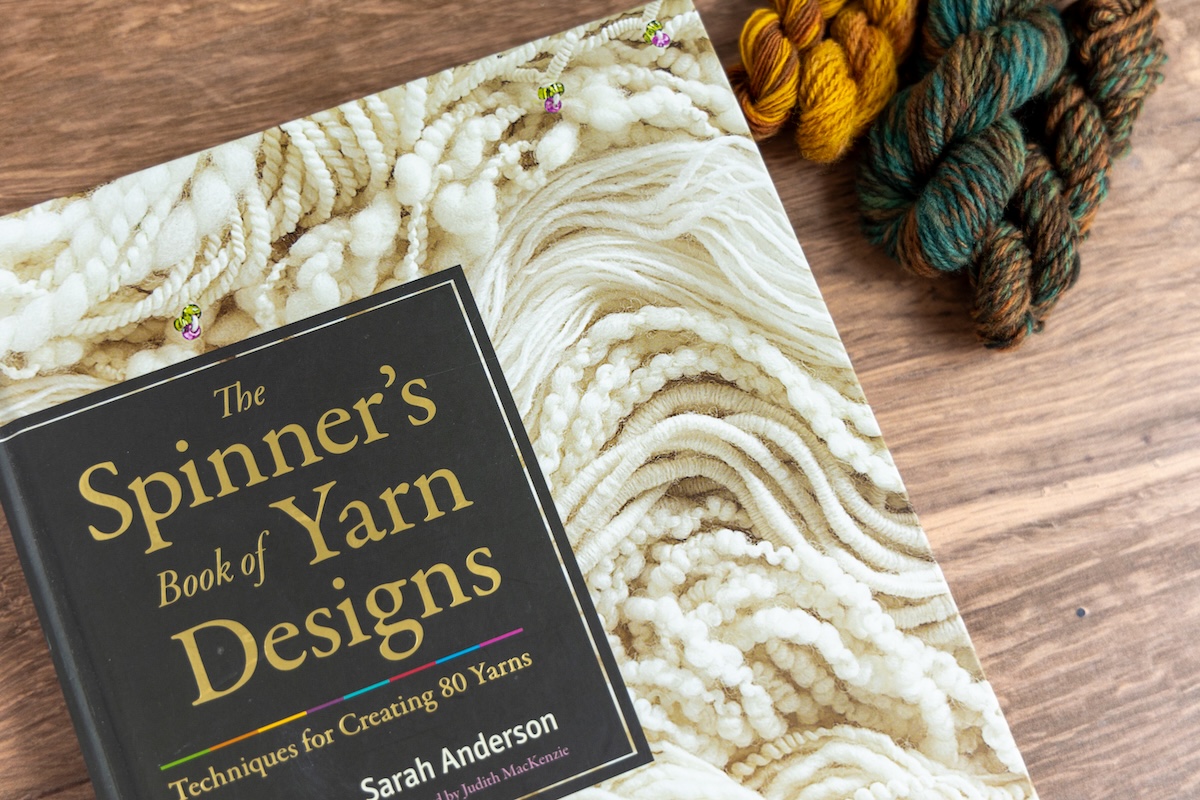
Sarah Anderson’s book, The Spinner’s Book of Yarn Designs.
TIPS on Plying Handspun Yarn:
Everyone has their own preference on how to ply. Here are some things to ask yourself when choosing which plying method is best for you:
- Does your current system allow you to start plying from the same end you started spinning?
If so, your handspun will be smoother and less likely to pill. I accomplish this by transferring the singles from the spinning wheel’s bobbin (primary bobbin) to a secondary bobbin, a technique referred to as rewinding singles. Note: I use Leclerc’s flanged sectional spool weaving bobbins as my secondary bobbins. - How heavy are your spinning wheel’s bobbins?
I normally spin very fine yarns. To ensure the weight of a full bobbin does not affect the character of my yarn, I ply from lightweight secondary bobbins. Depending on one’s plying method, heavier bobbins can create more drag and stretch the singles during plying. This is more noticeable when dealing with fine highly-crimped wool singles. My spinning wheel’s bobbins weigh between 100 and 105 grams. The plastic sectional bobbins I use on the other hand weigh 35 grams.
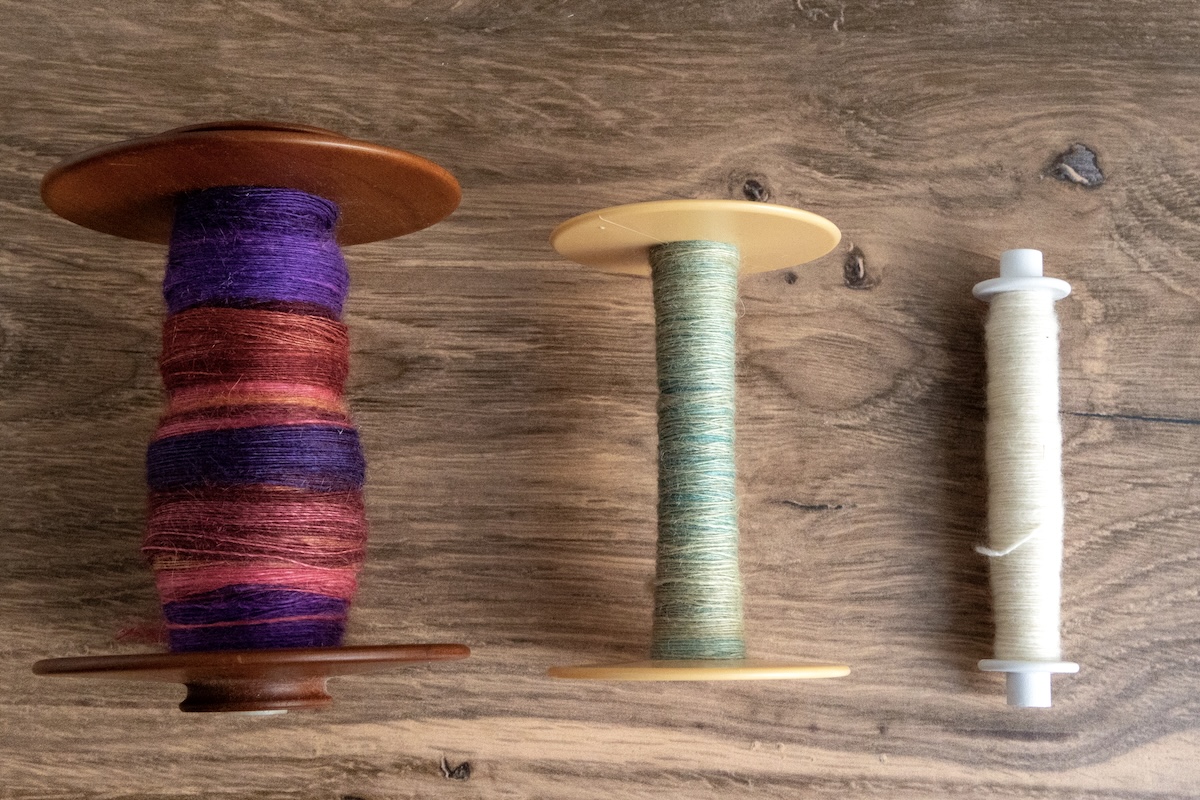
From left to right: Spinning wheel bobbin (primary), Leclerc spool bobbin (secondary), and Schacht shuttle bobbin (secondary).
- Was extra twist added as you transferred your singles from the primary storage package to the secondary storage package?
Winding a plying ball by hand will add or remove twist from the singles depending on whether you wind away from or towards you. When you wind a ball using a nøstepinne or a weaving or spinning wheel bobbin winder, no twist is added or removed. - Does the storage package allow you to ply smoothly?
The singles loaded on the primary bobbin should be wound without “hills and valleys”. Transferring the singles from the primary bobbin to the secondary bobbin affords you the opportunity to wind the yarn smoothly up and down the bobbin. Smoothly loaded primary bobbins translate to a smoother plying experience.
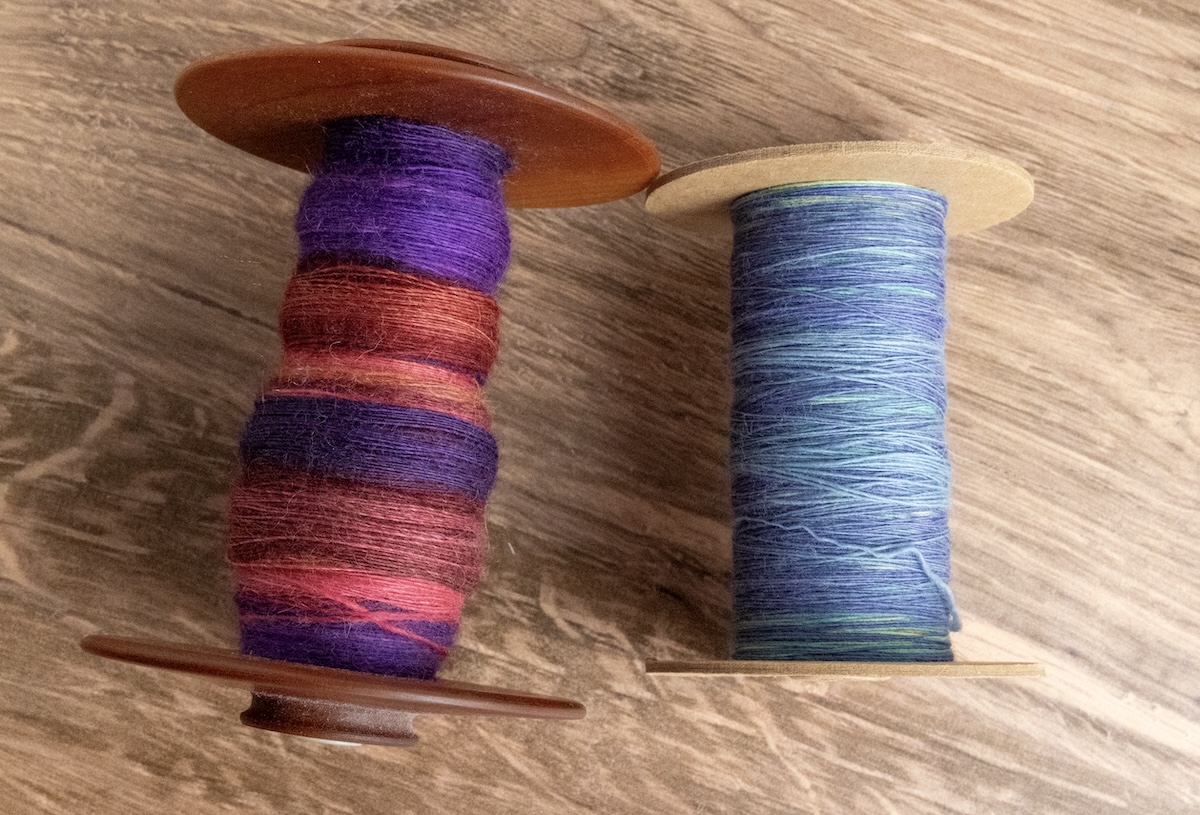
- Does your present system give you approximately 5 feet between the lazy kate and your back hand when plying?
The distance between the lazy kate and your back hand helps the singles twist even out a bit before you add the ply twist. If you were to tie a short ribbon around the singles close to the lazy kate, you would see the ribbon twirl as it works its way towards your hands. This is because if you give the singles some distance between the lazy kate and your back hand, the twist evens out a bit and will move from over-twisted sections in the singles to sections with less twist. Some wheels have a built-in bobbin storage area. Plying your handspun from the bobbin storage area does not provide the necessary distance needed for the twist to even out. - Does your present system prevent the bobbin from picking up speed as it empties and you draw nearer to the bobbin’s core?
A brake on your lazy kate or the “Plying Through Rings” method will mitigate this issue.
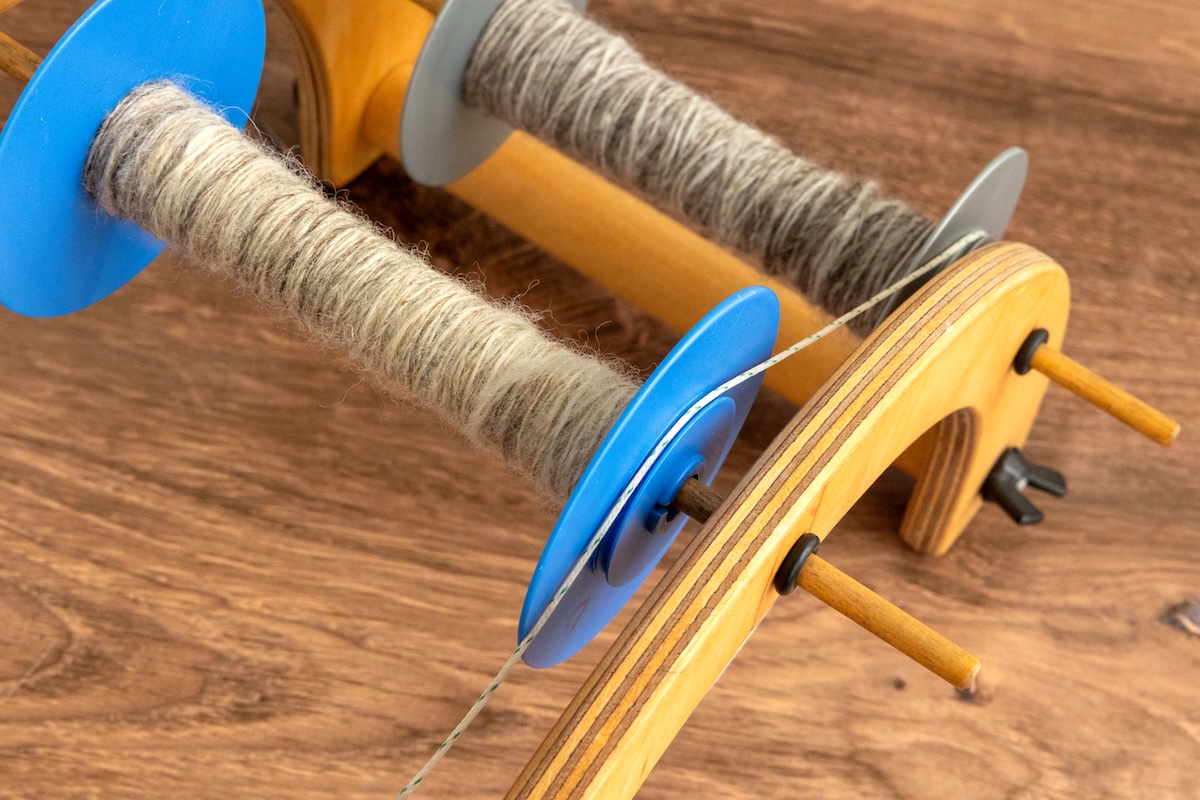
Plying Through the Rings
In 2016, I published an article in PLY magazine on a plying method I developed to help me ply multi-ply yarns. Since that time, I have made some minor changes to my technique. The School of SweetGeorgia Nuances to Spinning Better Yarns course reviews this Plying Through Rings technique, both the original and updated methods.
What are the advantages of Plying Through Rings?
This method makes the plying experience more enjoyable and your yarn more consistent. In addition:
- Rewinding the singles onto secondary bobbins reorganizes how the singles are loaded on the bobbin. Doing away with the little bumps and valleys results in a seamless plying experience.
- Maintaining the plying momentum reduces pig-tailing/curlicues. This means pigtails seldom make their way to your hands.
- With this system, I no longer feel the need to let singles rest on bobbins for 24 hours before plying. One exception would be if I was plying very fine, highly-twisted singles.
- Using secondary bobbins sets you up to ply from the same end you started spinning your singles from. This results in a smoother yarn and a yarn that pills less. The yarn will also have less nap on its surface which helps to preserve any lustre the fibre may have.
- The distance between the lazy kate to the rings, and then, the rings to your hands provides the distance needed for the singles twist to even itself out.
- Plying from lighter-weight secondary bobbins helps you to straighten, but not stretch, the singles as you ply. This is especially important when dealing with fine woollen singles.
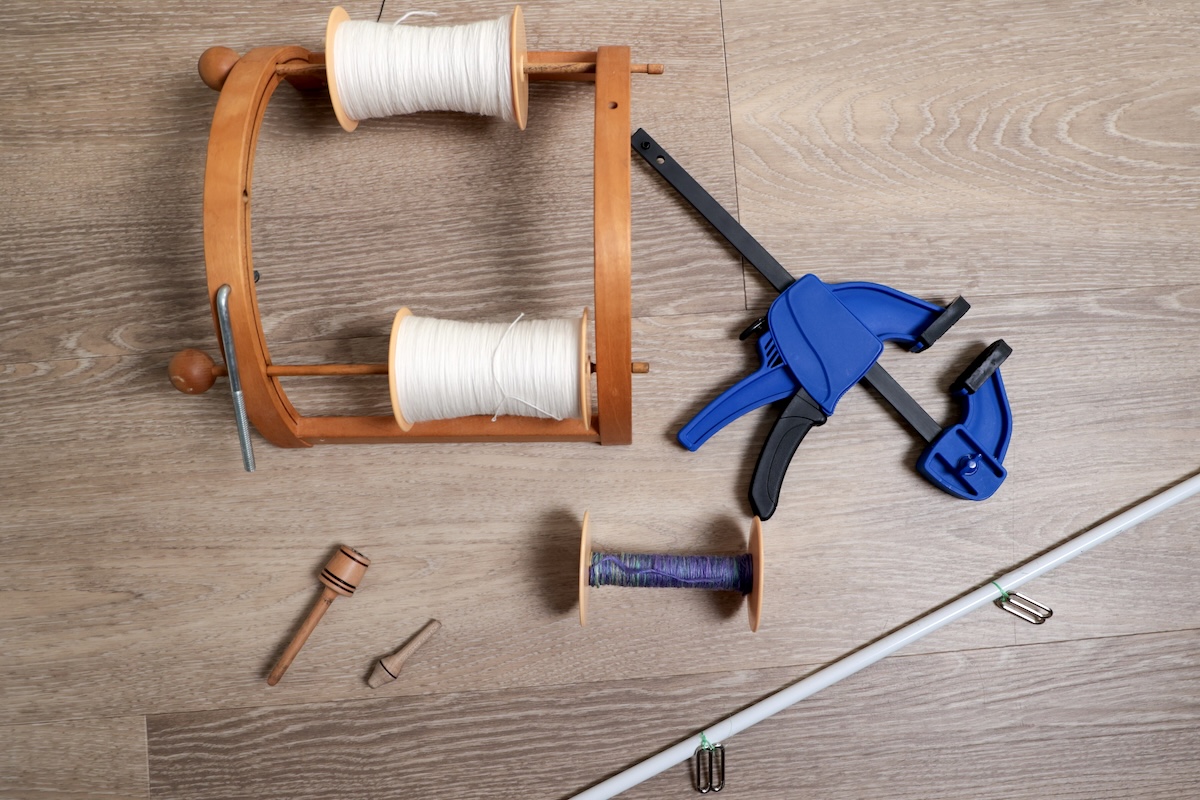
Conclusion
If you find yourself putting off plying until every bobbin you own is filled to the brim and you have run out of bobbins or if you are not happy with your handspun plied yarn, give the Plying Through Rings method a try. It makes for a seamless plying experience and has the added bonus of improving consistency in your plying. You will also find it so much easier to manage singles when working with multi-ply yarns.
There are many other plying methods besides the one I use. My advice is to choose the method that works best for you. One that fits into your space, your life, and that gives you the nicest results in your handspun.
Discover more spinning articles from Kim McKenna and other experts eager to share their knowledge with you.
The post Plying Tips for Handspun Yarn Success appeared first on SweetGeorgia Yarns.
Comments
Post a Comment